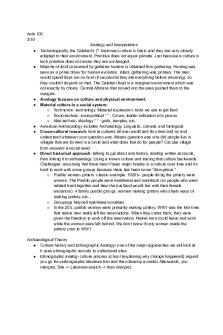Chapter 2 - Summary - Archaeology Essentials: Theories Methods and Practice PDF

| Title | Chapter 2 - Summary - Archaeology Essentials: Theories Methods and Practice |
|---|---|
| Course | Introduction to Archaeology |
| Institution | University of Lethbridge |
| Pages | 4 |
| File Size | 101.7 KB |
| File Type | |
| Total Downloads | 7 |
| Total Views | 143 |
Summary
Chapter 2 - Summary...
Description
Chapter 2: Archaeological Evidence
I.
Basic Categories of Evidence:
– Archaeologists primarily study artifacts (objects used, modified or made by humans). – The majority of artifacts we study include: - architecture - ceramics - lithics (oldest evidence) - metals - organics (perishable items) - ecofacts (unmodified organics) - human remains – Ecofacts: natural objects that reflect human presence - include food remains as well as soils and sediments affected by occupation - diet - social status - environment – Human remains: - diet - health - demographics and origins - ritual behaviour - environment – What can artifacts tell us? - age of the artifact and the site it is from - technology (how was it made? What was it for?) - social identity (style of the artifact) - trade and social contacts (nonlocal objects) - belief systems (decoration)
- foodways (tools and ceramics) – Archaeological sites: - places where artifacts, features, structures, ecofacts, human remains are found together. - sites can be: a) large and occupied over long periods (towns, cemeteries, etc.) b) small and the products of ephemeral occupation (campsites, isolated burials, etc.) II.
The Importance of Context
– In order to interpret human activity at a site we need to understand the context of its contents (artifacts, ecofacts, features, etc.) – Context: the location of an artifact at a site. – Context consists of: 1) Matrix: material surrounding an artifact (sediment such as gravel, sand, or clay) 2) Provenience: horizontal and vertical position of the artifact within the matrix 3) Association with other artifacts or archaeological remains in the same matrix – Primary vs. secondary context: - Primary context: the original context in which an artifact is deposited. - Secondary context: an artifact moved from its primary context (e.t, looters, development, curation, etc.) - Important to determine whether context is primary or secondary in order to help us better understand the associations between artifacts.
III.
Site Formation Processes
There are 2 types of site formation processes: 1. Cultural Formation Processes
– The deliberate or accidental activities of human beings as they make or use artifacts,
build or abandon buildings, plow their fields and so on.
– Two types: a) processes reflecting activities taking place before the artifact enters the ground (original human behaviour). b) Processes reflecting activities after the artifact is deposited.
2. Natural Formation Processes
– Natural events that both the burial and the survival of the archaeological record. – Extreme events (natural disasters) can destroy sites yet contribute to preservation (lava flows, ash falls, mudslides, flooding) – Sites are gradually covered by sand and soils deposited by decomposition, wind, or water. – Natural processes generally either: a) lead to the destruction of artifacts b) lead to the preservation of artifacts – Inorganic material preserve far better than organic materials. – Inorganic artifacts that tend to preserve the best in most contexts are include: a) stone tools b) fired clay (ceramics) c) metals (acids and salts can adversely affect preservation) – Preservation of organic artifacts is largely dictated by: 1) The matrix - Anaerobic (lack of oxygen): environments prevent oxidation of metals and inhibit organic decay caused by microorganism. (preservative) - Bioturbation: the process by which soils are moved biological agents, such as worms. (destructive) - Certain chemicals in the matrix can both preserve and destroy artifacts, though most soil conditions alter or destroy organic materials.
2) The climate - Different climates will have different effects on artifacts. - Tropical climates are the most destructive: rain, acidic soils, warm temperatures, humidity, erosion, vegetation, and insects. - The survival of organic materials is limited to places with extreme moisture conditions. - Three conditions that preserve organic materials quite well include: 1) Arid: aridity (dryness) prevents decay due to lack of water. 2) Frozen: refrigeration stops decay processes (the Iceman). 3) Wet (anaerobic): waterlogged environments (“wetland sites”) work in various ways.
Experimental Archaeology - Studies the processes of preservation and decay over a long period of time. - Goal is to provide insight into the formation archaeological record. - Example: experimental earthworks in England, flintknapping, trampling behaviour....
Similar Free PDFs

Archaeology Dating Methods Essay
- 4 Pages

Chapter 2- Research Methods
- 16 Pages

Theories Chapter 2&3
- 16 Pages

Archaeology
- 2 Pages
Popular Institutions
- Tinajero National High School - Annex
- Politeknik Caltex Riau
- Yokohama City University
- SGT University
- University of Al-Qadisiyah
- Divine Word College of Vigan
- Techniek College Rotterdam
- Universidade de Santiago
- Universiti Teknologi MARA Cawangan Johor Kampus Pasir Gudang
- Poltekkes Kemenkes Yogyakarta
- Baguio City National High School
- Colegio san marcos
- preparatoria uno
- Centro de Bachillerato Tecnológico Industrial y de Servicios No. 107
- Dalian Maritime University
- Quang Trung Secondary School
- Colegio Tecnológico en Informática
- Corporación Regional de Educación Superior
- Grupo CEDVA
- Dar Al Uloom University
- Centro de Estudios Preuniversitarios de la Universidad Nacional de Ingeniería
- 上智大学
- Aakash International School, Nuna Majara
- San Felipe Neri Catholic School
- Kang Chiao International School - New Taipei City
- Misamis Occidental National High School
- Institución Educativa Escuela Normal Juan Ladrilleros
- Kolehiyo ng Pantukan
- Batanes State College
- Instituto Continental
- Sekolah Menengah Kejuruan Kesehatan Kaltara (Tarakan)
- Colegio de La Inmaculada Concepcion - Cebu











